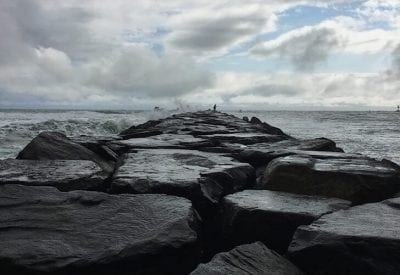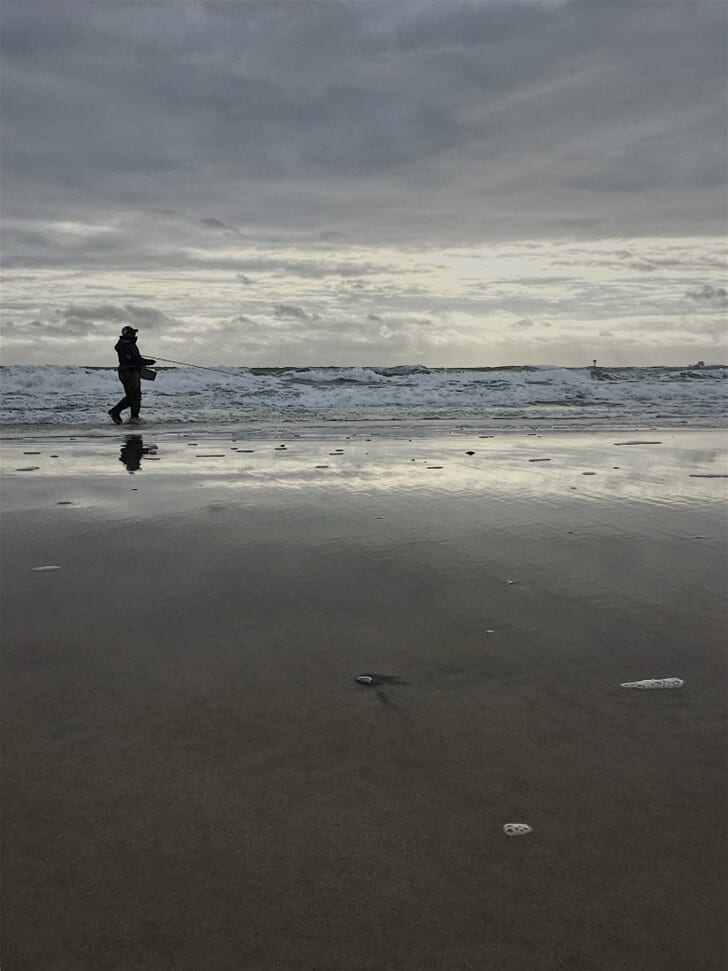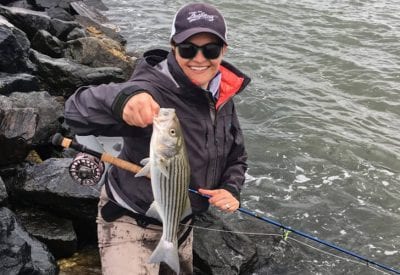By Alysson Cwyk of Fisher Guiding:
Scenario: you primarily fish tiny streams for trout, but your Instagram feed has been littered with photos of monster striped bass recently and it’s piqued your interest. What’s up with all these stripers and how can you get in on the action?
It’s the start of the #fallrun here in the Mid-Atlantic, where massive schools of striped bass are moving their way down south along the coast, chowing down on baitfish and hopefully flies, plugs, and live bait cast by hordes of fishers lined up and down the shoreline and on boats out chasing after birds working the water.
Saltwater fly fishing for striper is definitely different from trout fishing. For starters, you’re going to need a heavier rod to battle fish and winds—your trusty 5-wt does not stand a chance, and it’s more than likely not salt-friendly. I fish a 10-wt, although an 8-wt or 9-wt could do just fine. For your reel, you’ll need a size compatible with your rod with decent drag. Stripers are powerful fish, even a small schoolie will probably tug harder than any trout you’ve ever battled. Line wise, pick up some intermediate or sinking line to get your fly down in the water. If you’re not fully committed to fly fishing in the salt or do not want to spend a ton of cash, try purchasing a set up at the end of the summer/early fall when shops are heavily discounting product and making space for next season’s inventory. Better yet, borrow from a friend.
For your first-time pursuing striper, I recommend going out with a buddy who knows what they are doing or hiring a guide. But if you are up for some DIY, here are some tips to help you succeed in landing a #fallrun striper:
- Practice your double-haul: I cannot stress this enough. I think the key to saltwater fly fishing is getting your line out there and
dropping your fly with relative accuracy. I live in the middle of a city and have managed to find a park where I can practice my distance casting… albeit with comments and stares. Practicing at home will prepare you rather than wasting your time trying to figure it out when there’s a blitz 70 feet in front of you. Here’s a great video from the “First Lady of Fly Fishing” and National Casting Champion, Joan Wulff, to get you started.
- Learn to tie some knots: Someone may have told you that the improved clinch knot was the only knot you needed to know to tie your leader to a fly. Yes, it’s a solid knot, but whoever taught you that was wrong. Learn to tie knots that give your fly a range of motion when tied to your leader, such as Lefty’s loop or the non-slip loop knots. Your fly will move more realistically to resemble swimming baitfish.
- Seek out structure: It’s not a coincidence that stripers are also referred to as rockfish. Try fishing around rock formations, such as jetties and piles, bridges, docks, and grass beds. Baitfish will attempt to seek shelter around these areas, drawing in stripers looking to feed.
- Use a stripping basket: For safety reasons, use a stripping basket around your waist. There’s no need for you to get your line wrapped up around your legs as waves are pounding at your body or getting tripped up on a slick jetty.
- Wear studs/felt soles: If you are going to be fishing from a jetty or have the potential to climb through rocks, make sure your wading boots either have studs or felt bottomed soles. Wet rocks are extremely slippery and you don’t want to eat it as soon as you hook into a fish.
- Be mindful of the tide: Check out a tide chart before heading out so you know what you’re in for. If you walk out to a sandbar during low tide, make sure to make it back safely to shore before the tide rushes back in. Tides move faster than you think.
- Match the hatch, er, bait: Call up a shop in the area where you plan to fish to find out what type of bait are moving through the local
waters. There’s no need to bring every fly you own on a salt outing (same rings true for trout fishing). Attempt to match your flies to what’s in the water. And if all else fails, tie on a chartreuse and white Clouser.
- Pinch your barb: There’s nothing worse that hooking yourself mid-cast in windy conditions…except hooking yourself with a fly that still has a barb on it. Not only can a barbed hook be extremely difficult for you to remove from your body and may result in a trip to the emergency room, but a barbed hook can be hard to remove from a fish, which could lead to mortality.
- Strip set: And the most important tip: do not trout set! When you feel a tug, do not lift your rod tip up, but keep tension on your line and strip it in!
Do not be surprised if you don’t catch a striper on your first time out. You’ll need to explore an area to get a feel of it, understand how tides change the shape of the beach, and find where the fish are congregating. Be persistent. You’ll eventually land that coveted striper and never feel the desire to fish for trout in the fall ever again.
Alysson Cwyk is an angler from Philadelphia, PA, and a representative of www.FisherGuiding.com, where you can go to easily plan and book fishing trips with guides and charters worldwide. She also serves as president of the Delaware Valley Women’s Fly Fishing Association. You can follow more of Alysson’s fishing adventures on Instagram: @femmeonthefly.


 dropping your fly with relative accuracy. I live in the middle of a city and have managed to find a park where I can practice my distance casting… albeit with comments and stares. Practicing at home will prepare you rather than wasting your time trying to figure it out when there’s a blitz 70 feet in front of you. Here’s a great video from the “First Lady of Fly Fishing” and National Casting Champion, Joan Wulff, to get you started.
dropping your fly with relative accuracy. I live in the middle of a city and have managed to find a park where I can practice my distance casting… albeit with comments and stares. Practicing at home will prepare you rather than wasting your time trying to figure it out when there’s a blitz 70 feet in front of you. Here’s a great video from the “First Lady of Fly Fishing” and National Casting Champion, Joan Wulff, to get you started. waters. There’s no need to bring every fly you own on a salt outing (same rings true for trout fishing). Attempt to match your flies to what’s in the water. And if all else fails, tie on a chartreuse and white Clouser.
waters. There’s no need to bring every fly you own on a salt outing (same rings true for trout fishing). Attempt to match your flies to what’s in the water. And if all else fails, tie on a chartreuse and white Clouser.